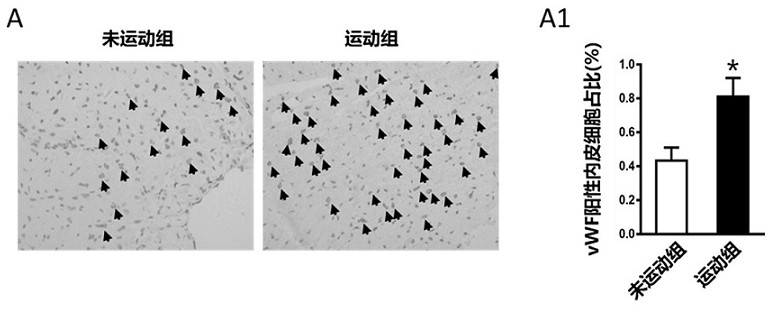Application of Ctrp15 in preparation of products for promoting angiogenesis and improving ischemia-related cardiac functions
A product, the technology of myocardial ischemia, applied in the field of medicine, can solve problems such as poor myocardial repair
- Summary
- Abstract
- Description
- Claims
- Application Information
AI Technical Summary
Problems solved by technology
Method used
Image
Examples
Embodiment 1
[0033] Example 1. Exercise-induced Ctrp15 protein secreted by skeletal muscle
[0034] 1. Exercise promotes functional recovery after cardiac ischemia and hypoxia injury
[0035] WT wild mice were selected, and the swimming experiment and acute myocardial infarction model were used to calculate the survival rate, cardiac function changes and pathological level of the mice after myocardial infarction to evaluate the changes of cardiac remodeling, and to clarify the effect of exercise on the protection of the heart on the posterior side of myocardial infarction. The degree of branch angiogenesis and cardiac function repair.
[0036] (1) Construction of the motion model
[0037] Swimming simulation exercise: start swimming for 10 minutes per day and gradually increase by 10 minutes per day, until after 50 minutes per day, exercise 6 days a week for 4 weeks to obtain exercise model mice.
[0038] (2) Construction of an animal model of myocardial infarction
[0039] The mouse mo...
Embodiment 2
[0119] Example 2. Application of Ctrp15 protein in the treatment or alleviation of cardiac injury
[0120] The supplementary protein overexpressing Ctrp15 is used to detect whether it can effectively alleviate cardiac injury: On the premise of successful model construction, a myocardial infarction model was established by using WT wild mice, and the supplemental protein overexpressing Ctrp15 was used to determine whether the exercise prescription based on Ctrp15 was confirmed by cardiac ultrasound and pathological detection. Therapeutic effect of promoting collateral angiogenesis on cardiac function repair after myocardial infarction.
[0121] Injured heart mice (MI) were treated with the protein Ctrp15 in vivo:
[0122] (1) In the same way as the heart injury animal model of Example 1, a mouse model of myocardial infarction (non-exercise group) was obtained;
[0123] (2) Preparation of protein Ctrp15:
[0124] The protein Ctrp15 (company: AVISCERA BIOSCIENCE; product number...
Embodiment 3
[0139] Example 3. Knockout of CTRP15 significantly aggravated heart damage after myocardial infarction
[0140] In order to clarify the protective effect of Ctrp15 on cardiac function, gene CTRP15 KO mice were constructed; WT and CTRP15 KO mice were simultaneously ligated the anterior descending coronary artery to establish a myocardial infarction model. Effects of cardiac injury after myocardial infarction.
[0141] (1) Construction of CTRP15 knockout mice
[0142] Compared with wild-type C57BL / 6 mice, CTRP15 knockout mice (named CTRP15-KO mice) only have the base C at position 5122 of the CTRP15 gene (sequence 2) deleted in the genome, and other genes remain unchanged.
[0143] The above-mentioned CTRP15 gene knockout mice can be prepared by using site-directed mutagenesis or other existing techniques, and the present invention takes the following as an example:
[0144] CTRP15 systemic knockout mice were constructed from Cyagen Biosciences.
[0145] The identified gene s...
PUM
 Login to View More
Login to View More Abstract
Description
Claims
Application Information
 Login to View More
Login to View More - R&D
- Intellectual Property
- Life Sciences
- Materials
- Tech Scout
- Unparalleled Data Quality
- Higher Quality Content
- 60% Fewer Hallucinations
Browse by: Latest US Patents, China's latest patents, Technical Efficacy Thesaurus, Application Domain, Technology Topic, Popular Technical Reports.
© 2025 PatSnap. All rights reserved.Legal|Privacy policy|Modern Slavery Act Transparency Statement|Sitemap|About US| Contact US: help@patsnap.com



